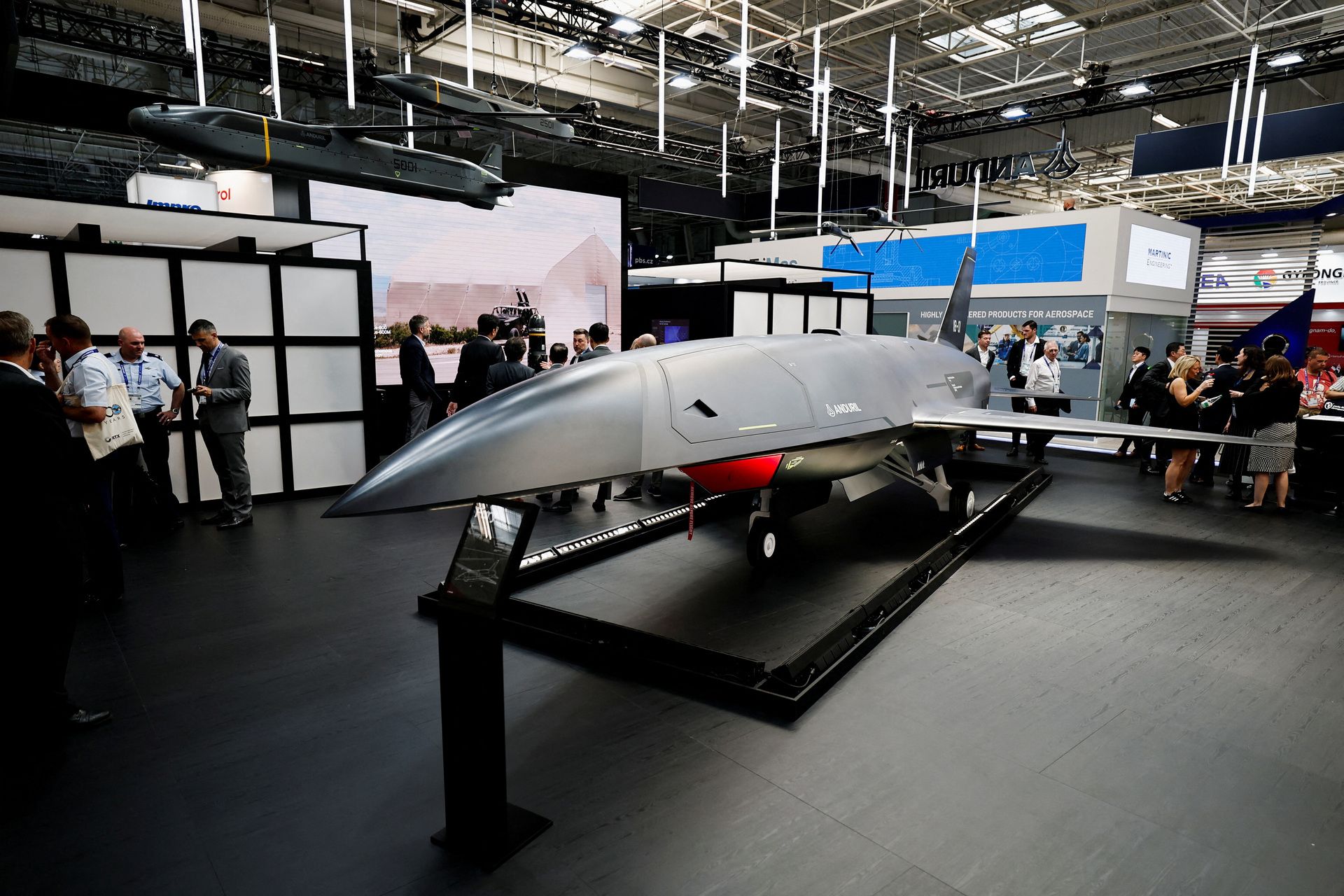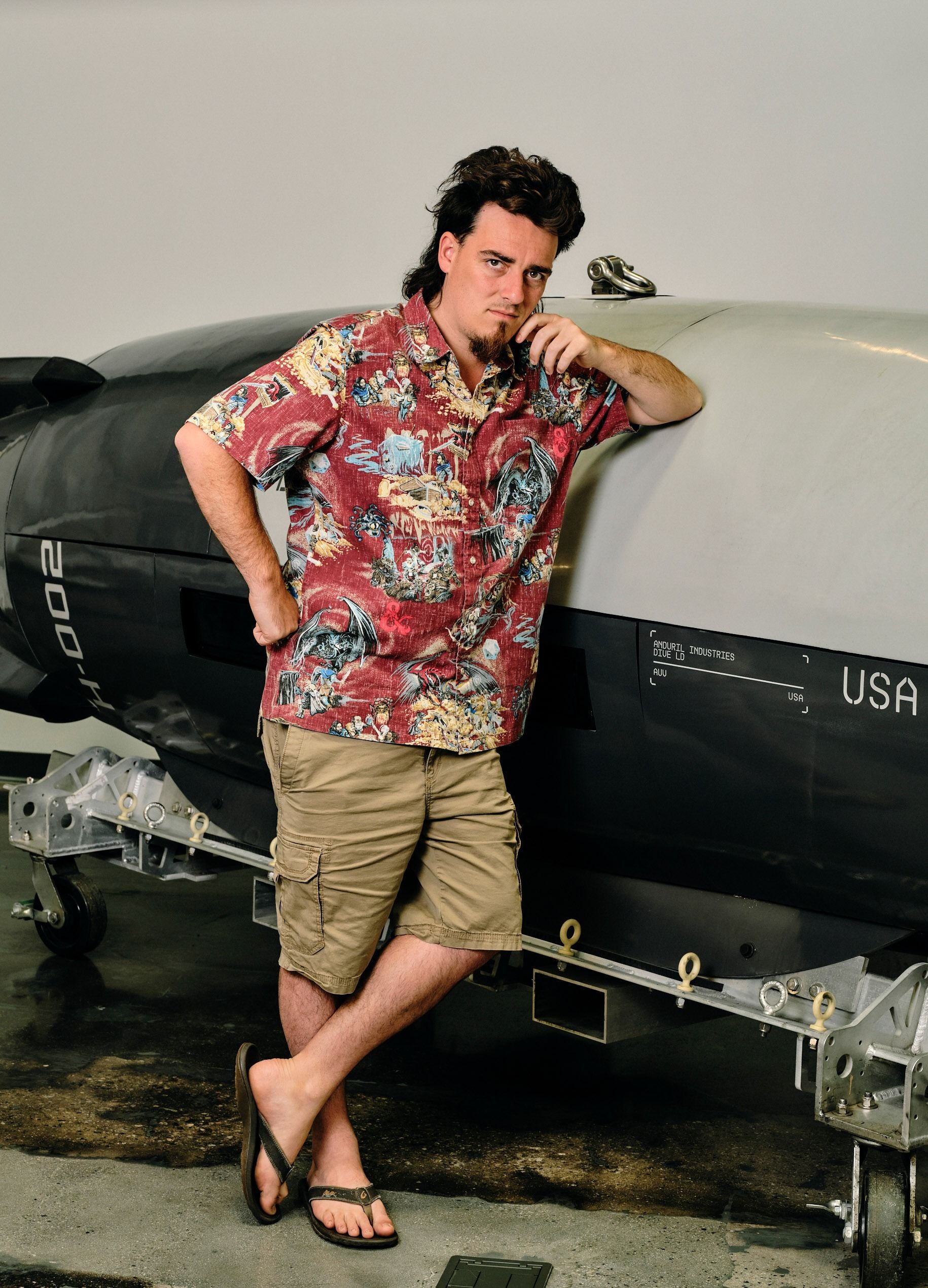- Deep Research Global
- Posts
- Anduril Industries SWOT Analysis (2026)
Anduril Industries SWOT Analysis (2026)
The defense technology sector is undergoing a seismic transformation, and at the forefront of this revolution stands Anduril Industries, a company that has ascended from a Silicon Valley startup to one of the most valuable private defense contractors in the United States.
With a recent valuation of $30.5 billion following a Series G funding round in June 2025, Anduril represents a new breed of defense companies challenging traditional contractors through cutting-edge artificial intelligence and autonomous systems.
This comprehensive analysis examines the strengths, weaknesses, opportunities, and threats facing Anduril Industries as we move into 2026 and beyond, providing insights into how this defense technology pioneer is reshaping national security infrastructure.
Want an audio version? Listen to the in-depth Anduril SWOT analysis on our Deep Research Global Podcast 👇
Table of Contents

Understanding Anduril Industries: Company Background
Founded in 2017 by Palmer Luckey, the inventor behind Oculus VR, along with several co-founders, Anduril Industries specializes in autonomous systems and advanced defense technology.
The company name, derived from J.R.R. Tolkien's "The Lord of the Rings," reflects its mission to provide powerful defensive capabilities to the United States and its allies.
Unlike traditional defense contractors that wait for government specifications, Anduril operates on a product-driven model, privately funding research and development to create finished systems that can be deployed off-the-shelf.
This approach has allowed the company to move with unprecedented speed in an industry known for slow procurement cycles.

Strengths: What Makes Anduril a Defense Industry Powerhouse
Cutting-Edge AI and Autonomous Technology
At the heart of Anduril's competitive advantage lies Lattice, an AI-powered operating system that serves as the central nervous system for all the company's autonomous platforms. Lattice connects sensors, hardware, and software across air, land, and sea domains, enabling real-time decision-making and coordination of multiple autonomous assets.
The system's machine learning capabilities allow it to process vast amounts of sensor data, identify threats, and recommend or execute responses with minimal human intervention. This technological foundation gives Anduril a significant edge over traditional defense contractors still relying on legacy systems.

Diverse Product Portfolio
Anduril has developed an impressive array of autonomous systems across multiple domains:
Air Systems:
Ghost: Autonomous surveillance drones capable of extended missions
Fury: An AI-powered unmanned fighter jet designed for collaborative combat
ALTIUS: Tube-launched autonomous air vehicles
Roadrunner: A reusable interceptor for counter-drone operations
Bolt: Man-portable autonomous air vehicles
Ground Systems:
Sentry Towers: AI-powered surveillance systems deployed along borders
Anvil: Counter-drone kinetic interceptors
Maritime Systems:
Dive-LD: Extra-large autonomous underwater vehicles
Ghost Shark: Advanced autonomous submarines developed in partnership with Australia
Record-Breaking Contract Wins
Anduril's capabilities have translated into substantial government contracts. In March 2025, the company secured a $642 million, 10-year contract with the U.S. Marine Corps to deliver counter-unmanned aircraft systems (C-UAS) for base protection. The company beat nine competitors for this Program of Record, demonstrating its technological superiority.
Additional major contracts include:
$159 million from the U.S. Army for mixed reality helmet systems (September 2025)
$99.6 million for the Army's Next Generation Command and Control prototype (July 2025)
$99 million Air Force contract for indefinite delivery/indefinite quantity services (February 2025)
Strategic Partnerships and Collaborations
Anduril has forged strategic alliances that enhance its technological capabilities and market reach:
OpenAI Partnership: In December 2024, Anduril announced a partnership with OpenAI to integrate advanced AI models into counter-drone systems, improving threat detection and response capabilities.
Meta Collaboration: In May 2025, Anduril partnered with Meta to develop extended reality (XR) products for military applications, leveraging Meta's VR/AR expertise.
RTX Joint Development: In October 2025, Anduril and RTX successfully tested an advanced solid rocket motor, combining traditional aerospace capabilities with Anduril's innovative approach.
Unprecedented Funding and Valuation Growth
Anduril's financial trajectory demonstrates investor confidence in its business model. The company has raised over $6.26 billion across multiple funding rounds, with its latest Series G round in June 2025 raising $2.5 billion at a post-money valuation of $30.5 billion—more than double its $14 billion valuation from August 2024.
This rapid valuation growth places Anduril among the 13 most valuable private companies globally and positions it to compete with legacy defense contractors like Northrop Grumman and General Dynamics.
Arsenal-1: Manufacturing at Scale
In January 2025, Anduril announced Arsenal-1, a 5-million-square-foot hyperscale manufacturing facility in Columbus, Ohio. This facility, expected to be completed in phases through 2035, will enable the production of tens of thousands of autonomous weapons systems annually.
Arsenal-1 represents a fundamental shift in defense manufacturing philosophy, moving from low-volume, high-cost production to high-volume, cost-effective manufacturing more similar to consumer electronics than traditional weapons systems.

Software-First Development Approach
Unlike traditional defense contractors that build hardware first, Anduril follows a software-first methodology. This approach allows for:
Rapid prototyping and iteration
Continuous software updates and improvements
Platform-agnostic deployment across multiple hardware systems
Reduced development timelines from years to months
This methodology has enabled Anduril to adapt quickly to emerging threats and incorporate feedback from field deployments much faster than legacy contractors.
Weaknesses: Challenges and Vulnerabilities
Limited Operational History
Despite impressive growth, Anduril remains a relatively young company with limited long-term operational data. Traditional defense contractors have decades of proven performance across multiple conflict scenarios and technological generations. Anduril's systems, while advanced, have limited combat deployment history compared to established platforms.
Dependence on Government Contracts
While Anduril has diversified its customer base somewhat, the company remains heavily dependent on U.S. government contracts. According to founder Palmer Luckey, the company generated approximately $1 billion in revenue in 2024, nearly doubling 2023 figures, but the company is not yet profitable.
This revenue concentration creates vulnerability to:
Changes in defense budget priorities
Shifts in political administrations
Procurement policy modifications
Contract delays or cancellations
Scaling Production Challenges
Moving from prototype development to large-scale manufacturing presents significant challenges. While Arsenal-1 addresses this concern, McKinsey research indicates that "most defense tech companies ultimately become hardware companies, and many are now facing the same scaling challenges as their more at-scale competitors."
Supply chain management, quality control at volume, and maintaining cost-effectiveness during scaling are hurdles that Anduril must overcome to achieve its production targets.
Talent Acquisition and Retention
The specialized nature of defense technology requires personnel with security clearances, technical expertise, and willingness to work in the defense sector. Competition for AI and robotics talent is fierce, with technology giants offering attractive compensation packages without the regulatory constraints of defense work.
Regulatory and Export Control Constraints
Defense technology faces stringent export controls and regulatory requirements. Anduril's autonomous weapons systems must navigate complex legal frameworks including:
International Traffic in Arms Regulations (ITAR)
Export Administration Regulations (EAR)
Department of Defense security requirements
Classified information handling protocols
These constraints limit the company's ability to serve international markets without extensive approvals and can slow deployment timelines.
Opportunities: Growth Vectors for 2026 and Beyond
Expanding Global Defense Market
The global military robots market is projected to grow from $25.47 billion in 2025 to $44.52 billion by 2034, representing a compound annual growth rate of approximately 6.4%. The autonomous defense systems segment is experiencing even more rapid expansion.
Geopolitical tensions, particularly regarding China's military modernization and Russia's actions in Ukraine, are driving increased defense spending across allied nations. The Trump administration's proposed $1 trillion defense budget for 2026 includes significant allocations for cybersecurity, artificial intelligence, and autonomous systems—areas where Anduril excels.
International Expansion
While Anduril has focused primarily on U.S. government contracts, international opportunities are substantial. The company has already established partnerships in:
Australia: Development of the Ghost Shark autonomous submarine for the Royal Australian Navy
United Kingdom: Base defense system demonstrations and potential deployments
Europe: Partnership with Rheinmetall to build military drones for European markets
NATO members and Indo-Pacific allies facing similar security challenges represent significant growth opportunities for Anduril's proven systems.
Emerging Technology Integration
Several technological trends present expansion opportunities:
Space Domain Awareness: Anduril has begun targeting the space domain with AI and autonomous systems for satellite tracking, debris monitoring, and space security applications.
Counter-Hypersonic Capabilities: As adversaries develop hypersonic weapons, demand for AI-powered detection and interception systems will grow.
Cyber-Physical Integration: Combining cyber warfare capabilities with physical autonomous systems creates new defensive and offensive possibilities.
Swarm Tactics: Coordinating hundreds or thousands of autonomous drones simultaneously represents a paradigm shift in military operations that plays to Anduril's Lattice platform strengths.
Commercial and Dual-Use Applications
While focused on defense, Anduril's technologies have potential commercial applications:
Border security and customs operations
Critical infrastructure protection
Maritime domain awareness for commercial shipping
Disaster response and search-and-rescue operations
Environmental monitoring
Expanding into these markets could diversify revenue streams and increase production volumes, reducing per-unit costs.
Potential Public Offering
Palmer Luckey has indicated that Anduril plans to become a publicly traded company, though no specific timeline has been announced. An IPO would:
Provide access to public capital markets
Increase company visibility and credibility
Offer liquidity for early investors and employees
Enable larger-scale acquisitions and investments
At its current $30.5 billion valuation, an Anduril IPO would be one of the largest defense technology offerings in recent history.
Acquisitions and Consolidation
Anduril has demonstrated willingness to grow through acquisition. In October 2025, the company acquired American Infrared Solutions (AIRS), a U.S.-based leader in infrared sensor technology.
As the defense technology sector matures, consolidation opportunities will emerge, allowing Anduril to acquire complementary technologies, talent, and market access.
Threats: Risks to Anduril's Growth Trajectory
Intensifying Competition
The success of Anduril and similar "neoprimes" has attracted attention and investment to the defense technology sector. Competitors include:
Established Defense Contractors: Companies like Lockheed Martin, Northrop Grumman, and Boeing are accelerating their own autonomous systems programs, leveraging decades of government relationships and infrastructure.
Defense Tech Startups: Companies such as Shield AI, Skydio, and Rebellion Defense are pursuing similar markets with competing technologies.
Technology Giants: As companies like Microsoft, Google, and Amazon reconsider their positions on defense work, they could become formidable competitors with vastly greater resources.
Ethical and Legal Challenges
Autonomous weapons systems face ongoing ethical debates and potential regulatory restrictions. International discussions about lethal autonomous weapons systems (LAWS) continue at forums like the United Nations Convention on Certain Conventional Weapons.
Concerns include:
Accountability for autonomous system decisions
Compliance with international humanitarian law
Meaningful human control requirements
Potential for arms races and rapid proliferation
DoD Directive 3000.09 establishes guidelines for autonomy in weapon systems, but regulations may tighten, requiring system redesigns or limiting deployment scenarios.
Technical Vulnerabilities
AI-powered autonomous systems face inherent vulnerabilities:
Adversarial AI Attacks: Sophisticated adversaries may develop techniques to deceive, confuse, or hijack AI decision-making systems.
Cybersecurity Risks: Connected autonomous systems present attractive targets for cyber attacks that could compromise entire fleets.
GPS Denial: Many autonomous systems rely on GPS for navigation; adversaries are developing GPS-jamming and spoofing capabilities.
Data Poisoning: If training data is compromised, AI systems could learn incorrect behaviors that manifest only in critical situations.
Economic and Political Uncertainty
Several external factors could impact Anduril's growth:
Defense Budget Fluctuations: While currently increasing, defense spending can shift rapidly based on political priorities, fiscal pressures, or geopolitical changes.
Technology Transfer Concerns: Strict controls on autonomous weapons technology could limit international sales, a key growth area.
Public Perception: Negative publicity surrounding autonomous weapons could generate political pressure to limit their development or deployment.
Recession Risk: Economic downturns typically lead to defense budget scrutiny, potentially delaying or canceling programs.
Traditional Contractor Resistance
Established defense contractors wield significant political influence and have deep relationships with Pentagon decision-makers. They may:
Lobby for procurement rules that favor incumbents
Challenge Anduril contracts through protests and litigation
Acquire or partner with competing defense tech startups
Develop their own competing autonomous systems
The traditional defense industrial base has survived previous disruption attempts and should not be underestimated.
Talent and Cultural Challenges
As Anduril scales from a startup to a major defense contractor, it faces cultural challenges:
Maintaining innovation culture while implementing necessary controls and processes
Attracting top technical talent that may prefer pure technology companies
Managing rapid workforce growth without diluting company values
Balancing speed and agility with quality assurance and safety requirements
Strategic Recommendations for 2026 and Beyond
Based on this SWOT analysis, several strategic priorities emerge for Anduril Industries:
Continue Technological Innovation: Maintain R&D investment to stay ahead of competitors in AI, autonomy, and sensor fusion technologies.
Execute Arsenal-1 Successfully: The Ohio facility's successful completion and operation is critical to achieving scale and cost advantages.
Diversify Customer Base: Expand international partnerships to reduce dependence on U.S. government contracts while respecting export controls.
Address Ethical Concerns Proactively: Engage with policymakers, ethicists, and the public to shape autonomous weapons regulations rather than react to them.
Strategic Acquisitions: Selectively acquire companies that provide complementary technologies, talent, or market access.
Develop Commercial Applications: Explore dual-use opportunities that leverage existing technology while expanding addressable markets.
Prepare for Public Markets: If pursuing an IPO, establish the governance, reporting, and operational practices required of public companies.
Conclusion: Anduril's Position in the Defense Transformation
Anduril Industries stands at the intersection of several powerful trends: increasing defense spending, the AI revolution, geopolitical tensions driving demand for advanced military capabilities, and a generational shift in how defense technology is developed and deployed.
The company's strengths—cutting-edge AI, diverse product portfolio, major contract wins, strategic partnerships, and strong financial backing—position it well to capitalize on significant opportunities in domestic and international markets.
The Arsenal-1 facility could fundamentally change defense manufacturing economics, while emerging technologies like space domain awareness and counter-hypersonics offer substantial growth potential.
However, Anduril faces real challenges. Limited operational history, scaling difficulties, intensifying competition, ethical concerns about autonomous weapons, and regulatory uncertainties could constrain growth or force strategic pivots. The company must navigate these threats while maintaining the innovation culture and speed that enabled its initial success.
As we move into 2026 and beyond, Anduril Industries represents a test case for whether Silicon Valley's disruption playbook can successfully transform the defense industrial base.
The company has already achieved remarkable success, but the most challenging phase—scaling from a successful startup to a sustainable major defense contractor—lies ahead.
For defense planners, investors, policymakers, and industry observers, Anduril's trajectory will provide important insights into the future of military technology and the evolving balance between traditional contractors and the new generation of defense technology companies reshaping national security infrastructure.
Reply